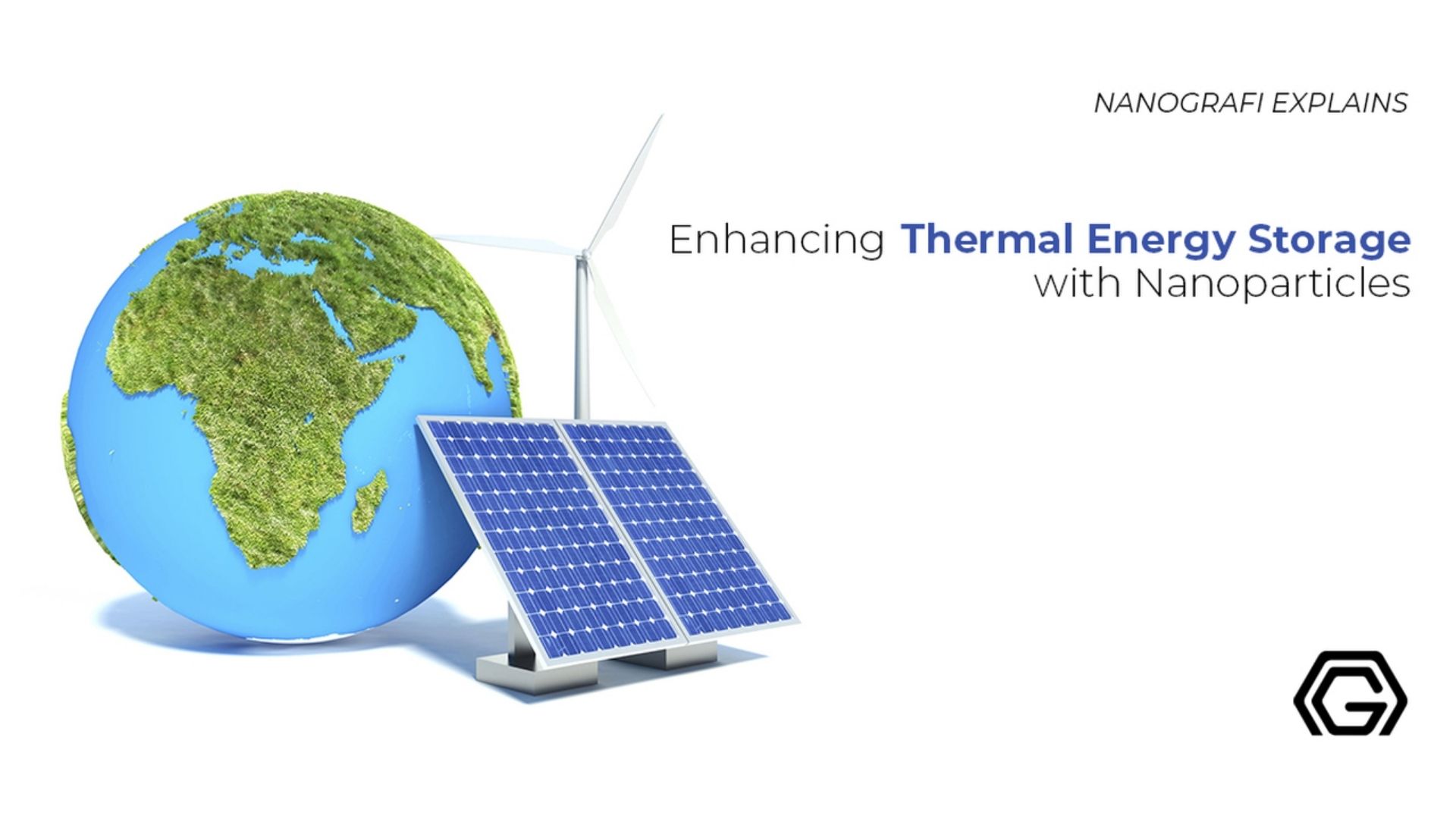Nanofluids Thermophysical and Oil Recovery Properties - Nanografi
A fluid that contains nanoparticles in the form of nanometer size is known as nanofluid.They are usually a mixture of metals, oxides, carbides, and carbon nanotubes. These fluids are actually the colloidal suspensions which are typically in a base fluid whereas the most significant known base fluids are water, ethylene glycol, and oil.
The two most common properties that these nanofluids hold are viscosity and thermal conductivity. They provide efficacy to the products in which they are utilized and due to this reason, they are widely used in the process of oil recovery. Nanofluids prove to be excellent for the oil recovery processes.
Introduction
The nanofluids have unique characteristics which makes them potentially beneficial in many heat transfer applications, like pharmaceutical processes, domestic refrigerator, microelectronics, hybrid-powered engines, fuel cells, heat exchanger, vehicle thermal/engine cooling management, and chiller, and in machining, grinding, and also for a reduction in boiler flue gas temperature. In comparison to the base fluid, convective heat transfer coefficient and improved thermal conductivity are displayed by them. The suitability of nanofluids in the applications of convective heat transfer is decided by the rheological behavior of nanofluids. Special acoustical characteristics are contained by the nanofluids and in ultrasonic fields, nanofluids display extra shear-wave reconversion of an incident compressional wave; and as the concentration increases, the effect becomes more pronounced.
Even though all the recent papers assume nanofluids to be a two-phase fluid, in computational fluid dynamics (CFD), they are predicted as single-phase fluids. Single-phase fluid's classical theory can be implemented where nanofluid’s physical characteristics are taken as a properties function of both the constituents and the concentrations of the constituents.A two-component model being used by the nanofluids is simulated in the latest alternative approach.
Near the contact line, the nanoparticle's solid-like ordering structure is assembled by diffusion which enhances the nanofluid droplet’s spreading, leading to an increase in the structural disjoining pressure in the contact line’s vicinity. Although, for small droplets, such improvement is not seen as they have the diameter of a nanometer scale, because the diffusion time scale is bigger than the wetting time scale.
Thermophysical Properties of Nanofluids
At a given rate, the fluid’s viscosity determines its resistance to deformation. It corresponds to the thickness informal concept for liquids, for instance, water has a lower viscosity than syrup.
The fluid has the adjacent layers in relative motion, causing an internal force of friction between the layers, known as viscosity. For instance, in the tube, when a fluid flows, then in comparison to the tube's walls, it runs more quickly near the axis of the tube. Some experiments show that for sustaining the flow through the tube, stress (difference of pressure between the tube’s two ends) is needed because for overcoming the force of friction between the fluid’s layers that are in relative motion altogether, a force is needed: the viscosity is proportional to the force’s strength.
Inviscid or ideal fluid is a kind of fluid having zero resistance to shear stress. At extremely low temperatures in super-fluids, zero viscosity is seen. Thermodynamics' second law needs all of the fluids to have positive viscosity, as technically, these fluids are viscid or viscous. High-viscosity fluids with pitch may appear as a solid.
Thermal Conductivity of Nanofluids
In comparison to liquids, solids have greater thermal conductivity. When seen in comparison with the solid’s thermal conductivity like metal, the commonly used fluids in applications of heat transfer, for instance, engine oil, ethylene glycol, and water have low thermal conductivity. So, the liquid’s conductivity can be improved by adding the small solid particles inside the fluid, but the addition of large solid particles is difficult due to the following main reasons.
- Unstable mixtures result in sedimentation.
- Large pumping power is needed for the addition of large solid particles, therefore, expensive.
- The walls of the channel may also be eroded by the solid particles.
Solid particles are not used because of these problems, as they make them not feasible, practically. The latest discoveries in nanotechnology have made the introduction of small solid particles with 10nm or smaller diameter. Nanofluids are liquids that have higher thermal conductivity. In comparison with other materials, the highest thermal conductivity is possessed by carbon nanotubes.
Nanofluids for Oil Recovery Applications
In the 1980s, the research on nanotechnology started extensively, and still, in the scientific world, it is a wonder. Between the Bulk and quantum effect, the boundary is the nanoscopic scale, that’s why only the behavior of the nanoparticles can be explained by quantum laws and classical physics, that too to some extent. Although, the properties are not known in detail, and also the cause of this behavior is unknown. In the nanoscale, contrary to the large-scale counterparts, the performance of particles is completely different. Some scientists say that the quantum effect or the atoms’ higher density at these particles’ large surface area is the reason.
In today’s world, nanoparticles have widened their applications due to their remarkable characteristics. The industry of gas and oil is discovering more advantages of this as they have been involved in this change closely. Recently, scientists discovered this technology’s high potential in the gas industry and upstream oil. One mission is the investigation of the probability of injecting nanoparticles for enhancing all conventional EOR methods applications.
A scientist also showed that, unlike conventional recovery techniques, tiny particles can penetrate into the pore spaces and, hence, lead to higher recovery. Also, he said that for altering characteristics of the reservoir, nanoparticles can be tailored, characteristics, for instance, wettability, control formation fines migration, or enhance mobility ratio. Since that moment, a huge amount of research is done in this field. Still, very much knowledge is needed to be discovered and learned. In this review, there is a summarization of the results of different research done so far in the area of the application of nanoparticles in EOR.
Currently, nanoparticles that are known, are categorized as fullerenes, graphene, carbon nanotubes, quantum dots, polymeric particles, metallic, and metal oxides. Mainly, this paper majorly focuses on nanotechnology applications in the industry of gas and oil, specifically in EOR. This article classifies nanoparticles into three categories, known as metal oxide, inorganic and organic particles.
To find out more, you can read Enhancing thermal energy storage with nanoparticles.
Nanoparticles’ most economic and basic use in enhancing oil recovery is the usage of nanoparticle suspension as a base fluid on its own without any heat or chemicals, also known as nanoflooding. Nanoflooding helps in the recovery of oil with the usage of nanomaterials via one or more methods, for instance, disjoining pressure, stabilizing emulsions and/or emulsions under tough conditions, interfacial tension reduction, and wettability alteration. For changing the solid surface's wettability, zirconia nanoparticles were used by some of the researchers meanwhile some were using modified graphene nanosheets. It was seen that if we are using nanofluid for altering the wettability, the process can be slow as the presence and size of nanoparticles also affect the process. The type of co-surfactant, ionic strength, and pH also affect. Wettability is shifted towards more water-wet by hydrophilic silica nanoparticles as proven by other researchers.
Near the walls of the pore, the thin oil film is trapped and in the throats of the small pore, oil is trapped. Also, silica nanoparticle's capability of reversing the carbonate rock's wettability to water wet from oil-wet has been tested. It was proved by the wettability tested through contact angle measurements that the usage of silica nanoparticles in relatively low concentration lessened the contact angle to 41° (water wet) from 156° (oil-wet).
This study also contains the ionic strength effects on the alteration of wettability using silica nanoparticles in constant concentration and changing salinity between 0.2 and 0 M. The results of the research guaranteed that in the presence of salinity, the alteration of wettability is enhanced. Na+ role is to help in the adsorption and release of silica nanoparticles.
1) The Effect of Nanoparticle on Surface Tension in Surfactant Solution
In the process of oil recovery, nanoparticles’ presence alters rheological characteristics and nanoparticles also enhance the surfactant solution's effects on the process. It changes the surfactant/oil interface's interfacial tension value, more effectively. At the interfacial layers, the presence of nanoparticles causes interfacial tension's observed reduction. In nanoparticle’s lower concentration, nanoparticles are attached to the surface of the liquid and because of the process of absorption, surface tension is decreased.
2) The Effect of Nanoparticles on Surfactant Adsorption Process
The surface-active agent's adsorption process was discussed under static circumstances on 0.315-0.2 mm diameter silica sand specimens. Nanofluid, surfactant aqueous solution of 100 ml, and 10 g silica sand were taken. In the solution, 2 different concentrations of surfactants were used and at 298 K temperature, the experiment was conducted. Interfacial tension value change determines the concentration of the Surface-active agent solution, for 3 days for every 24 h from specimen preparation time. After 24 hours of the experiment with sulphanole, desorption was seen of some surface-active agents, then stabilization of the process occurred. In nanoparticle presence, the process of adsorption of sulphanole is more stable and the value of surfactant adsorption reaches 18.5 and 14.5 times.
3) The Effect of Nanoparticles on Oil Wettability
In presence of nanoparticles and surface-active agents, oil wettability was further determined. The concentration of nanoparticles was 0.001% mass and the concentration of sulphanole was 0.05% mass. At 298K, the experiments were performed. Even with the addition of nanofluid, oil wettability stays the same, practically.
4) The Effect of Nanoparticles on optical Spectroscopy Results
Through the usage of a UK-spectrophotometer, and Lambda-40 spectrophotometer, spectra were obtained. Nanofluid with a less effective composition was used intentionally for the results of optical spectroscopy for the purpose of showing clear differences in process of absorption because of the presence of nanoparticles, even in that case. Every experiment has its own different procedures. For this experiment, an aqueous surfactant solution with 0.0078% sulphanole mass was used. Sulphanole powder’s and sulphanole’s (IR) infra-red spectra with nanostructured component, isolated from aqueous solutions.
Conclusion
Nanofluids play a vital role in oil recovery methods because they have a great influence on the surfactant absorption process as well as on the oil wettability. Other than that these have a great influence on the optical spectroscopy results as well. In conclusion, nanofluids are extremely necessary for enhanced oil recovery processes because of their effective properties and the influence that they have on the products they are used for.
To discover the latest articles in graphene, you can visit Blografi.
References
Alnarabiji, M. S., & Husein, M. M. (2020). Application of bare nanoparticle-based nanofluids in enhanced oil recovery. Fuel, 267, 117262. https://doi.org/10.1016/J.FUEL.2020.117262
Computational fluid dynamics - Wikipedia. (n.d.). Retrieved April 19, 2024, from https://en.wikipedia.org/wiki/Computational_fluid_dynamics
Enhancing Thermal Energy Storage with Nanoparticles - Nanografi Nano Technology. (n.d.). Retrieved April 19, 2024, from https://nanografi.com/blog/enhancing-thermal-energy-storage-with-nanoparticles/
Heat Transfer Fluid and Industrial Applications. (n.d.). Retrieved April 19, 2024, from https://www.azom.com/article.aspx?ArticleID=12736
Nanofluid - Wikipedia. (n.d.). Retrieved April 19, 2024, from https://en.wikipedia.org/wiki/Nanofluid
Nanotechnology to Better the Diesel Engine Performance - Nanografi Nano Technology. (n.d.). Retrieved April 19, 2024, from https://nanografi.com/blog/nanotechnology-to-better-the-diesel-engine-performance/
Negin, C., Ali, S., & Xie, Q. (2016). Application of nanotechnology for enhancing oil recovery – A review. Petroleum, 2(4), 324–333. https://doi.org/10.1016/J.PETLM.2016.10.002
Rezk, M. Y., & Allam, N. K. (2019). Impact of Nanotechnology on Enhanced Oil Recovery: A Mini-Review. Industrial and Engineering Chemistry Research, 58(36), 16287–16295. https://doi.org/10.1021/ACS.IECR.9B03693/ASSET/IMAGES/LARGE/IE9B03693_0008.JPEG
Suleimanov, B. A., Ismailov, F. S., & Veliyev, E. F. (2011). Nanofluid for enhanced oil recovery. Journal of Petroleum Science and Engineering, 78(2), 431–437. https://doi.org/10.1016/J.PETROL.2011.06.014
Recent Posts
-
MXenes from MAX Phases
MXenes, a group of two-dimensional materials derived from MAX phases, are gaining significant tracti …19th Oct 2024 -
Preserving History with Graphene's Power
Cultural artifacts are at risk of deterioration over time due to the destructive effects of both na …11th Oct 2024 -
The Role of Graphene in Neuroelectronics
Neuroelectronics is an interdisciplinary field that aims to develop devices that can interact with t …4th Oct 2024







